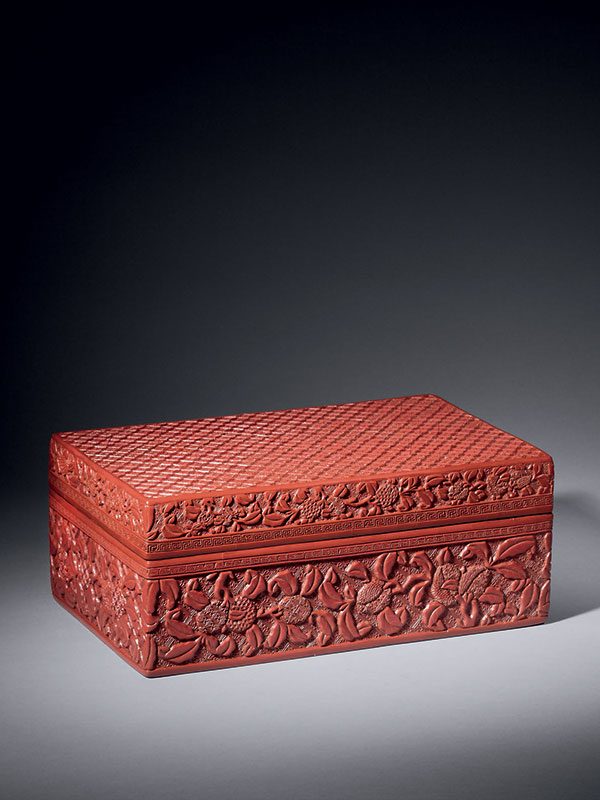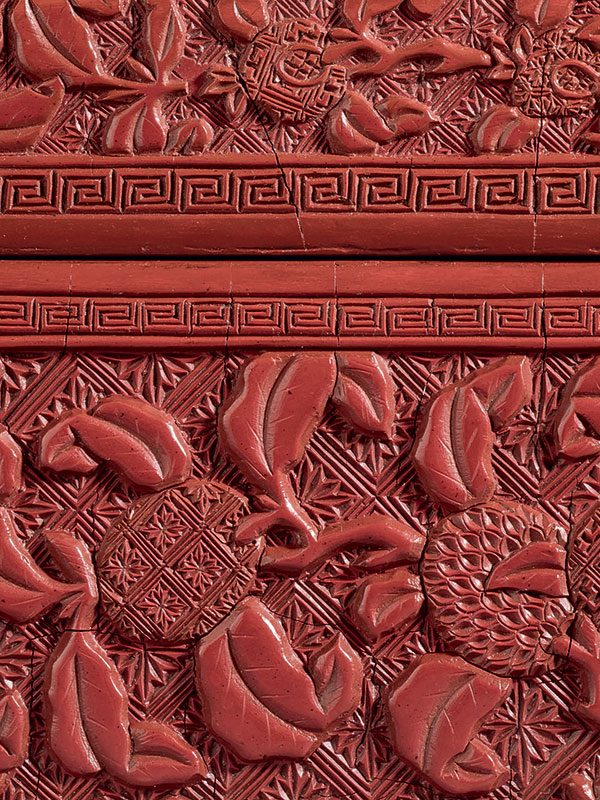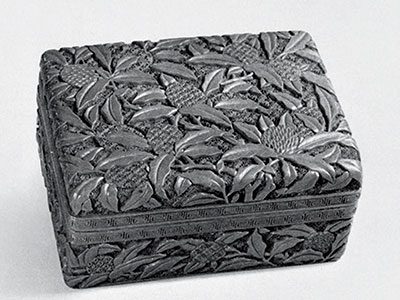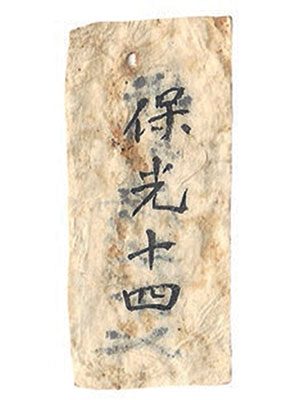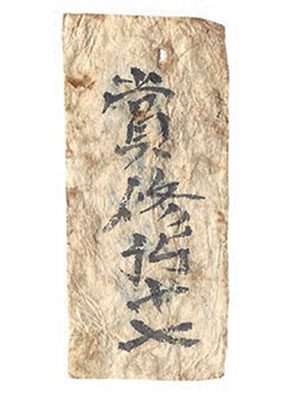Lacquer box with lychee decoration
A red lacquer box of rectangular form and with a flat base. The flat top is decorated with a densely carved design of starburst diaper on a diamond-shaped ground. The straight sides are adorned with lychee fruits among branches and curled leaves. The lychee fruits are detailed with different designs including starburst and wan diapers. The rims of the cover and the box are lipped and framed by a band of key-fret pattern. The interior and the base are lacquered in black. A rectangular paper label, originally attached to the base of the box, bears a five-character inscription in calligraphy, reading Shang Xiu Zhu Shi Qi (‘Watching Slender Bamboo, Seventeen’). The other side of the paper label has a four-character inscription, Bao Guang Shi Si (‘Preserving Light, Fourteen’).
The word for lychee, lizhi in Chinese, is homophonous with lizi, meaning ‘to have a son to continue the family name.’1 As the favourite fruit of Yang Guifei, a beloved concubine of the Tang Emperor Xuanzhong, who ordered a daily delivery of fresh lychees to Yang Guigei, the lychee is also a symbol of love and romance.[2] A closely comparable rectangular lacquer box similarly carved with lychee decoration and with key-fret borders, dated to the mid-Ming dynasty, is in the collection of the Palace Museum, Beijing (fig. 1).3 A rectangular lacquer box of similar size and proportions, adorned with a pair of birds among peony flowers on a comparable starburst diaper, is dated to the Ming dynasty, 16th century and in the collection of the National Palace Museum, Taipei.[4]
According to the label Shang Xiu Zhu Shi Qi (‘Watching Slender Bamboo, Seventeen’), this lacquer box may have once been used in the Qing Court. Shang Siu Zhu (‘Watching Slender Bamboo’) was one of the studios located inside the Shu Qing Yuan (‘Court of Purity’), a royal garden-palace complex just next to the Forbidden City along Lake Taiye, which was built during the reign of the Qianlong emperor (1736 – 1795). According to the Qing historical record Guochao Gongshi Xubian (‘A Supplemental History of the Palace during the Qing dynasty’), the Kangxi Emperor (1661 -1722) wrote this poetic name ‘Shang Xiu Zhu’ on a horizontal board, which became the title of the studio and the board was hung above the entrance of the studio.[5] The two characters Shi Qi (‘seventeen’) following the studio’s name possibly indicate that this box was catalogued as number seventeen in the studio’s antiquity collection. It is well known that Emperor Qianlong was both a collector and a curator, who displayed his collections in a domestic setting in which he could regularly examine, touch and write about them.[6]
The other side of the label is inscribed Bao Guang Shi Si (‘Preserving Light, Fourteen’), which might refer to another studio inside the royal garden Shu Qing Yuan. One label with both sides written with a studio name has rarely been found or studied by scholars. This unusual practice may suggest that this lacquer box might have been originally located in the studio of Bao Guang, and was later moved to the studio of Shang Xiu Zu.
1 Tse Bartholomew, T. Hidden Meaning in Chinese Art, Asian Art Museum, San Francisco, 2006, 3.19, p. 73
2 Welch, P. B. Chinese Art: A Guide to Motifs and Visual Imagery, Tuttle Publishing, Hong Kong, 2008, p. 54
3 Gugong Bowuyuan Cang Diaoqi (Chinese Lacquer in the Palace Museum, Beijing), Wenwu chubanshe, 1985, no. 122
4 Carving the Subtle Radiance of Colors: Treasured Lacquerware in the National Palace Museum, Taipei, 1999, no. 40, p. 62
5 Guochao Gongshi Xubian (‘A Supplemental History of the Palace during the Qing dynasty’), vol. 63
6 Yu, Hui-Chun, ‘Qianlong’s Divine Treasures: The Bells in Rhyming-the-Hall’ in Asia Major, Third series, vol.22, no. 2, 2009, pp. 129-130
剔紅荔枝紋長方盒
明 十五 – 十六世紀
長:29 公分 寬:18 公分 高:12 公分
長方形盒,平頂直壁,子母口,通體髹朱漆。蓋面滿雕四方形錦紋,側邊滿雕荔枝紋,枝葉錯落。盒 與蓋緣各飾回紋一周。盒內及盒底髹黑漆。盒內底原貼有一長方形紙標籤,籤上墨書「賞修竹十七」; 經移除後,發現紙籤背面另墨書「保光十四」。據考,「賞修竹」與「保光」可能指涉清宮園林「淑 清院」其中的「賞修竹」室及「葆光」室,而本盒可能於不同時期陳設於兩室之中。淑清院位於南海東北角,為乾隆時期修建的小型園林。據《國朝宮史續編》卷63,〈聖製韻古堂詩(辛亥)〉載:『南室,聖祖仁皇帝御筆匾曰:「賞修竹」。』顯示「賞修竹」匾原由康熙帝所題,後 懸掛於韻古堂(亦位在淑清院內)南室為名。〈御製淑清院詩(戊午)〉再載:『院東北隔水有室,南 向,聖祖仁皇帝御筆匾曰:「葆光」。高宗純皇帝御筆聯曰:「天向淡間無礙迥,雲從閑處有餘姿。」又聯曰:「心觸清機親翰墨,目遊潤景足精神。」』表示「葆光」匾亦原由康熙帝所題。現已知清宮舊藏中,確有類似本品之剔紅荔枝紋長方盒,尺寸較小,盒蓋與盒側於方錦紋上滿雕荔枝 紋,蓋與盒緣亦各雕飾回紋一周,定年為明中期作品,現藏於北京故宮博物院。另一件清宮舊藏,明 代十六世紀剔紅長方盒,盒蓋雕雙鳥牡丹紋,盒側作折枝茶花與梅花,尺寸稍小,現藏於臺北國立故 宮博物院。

